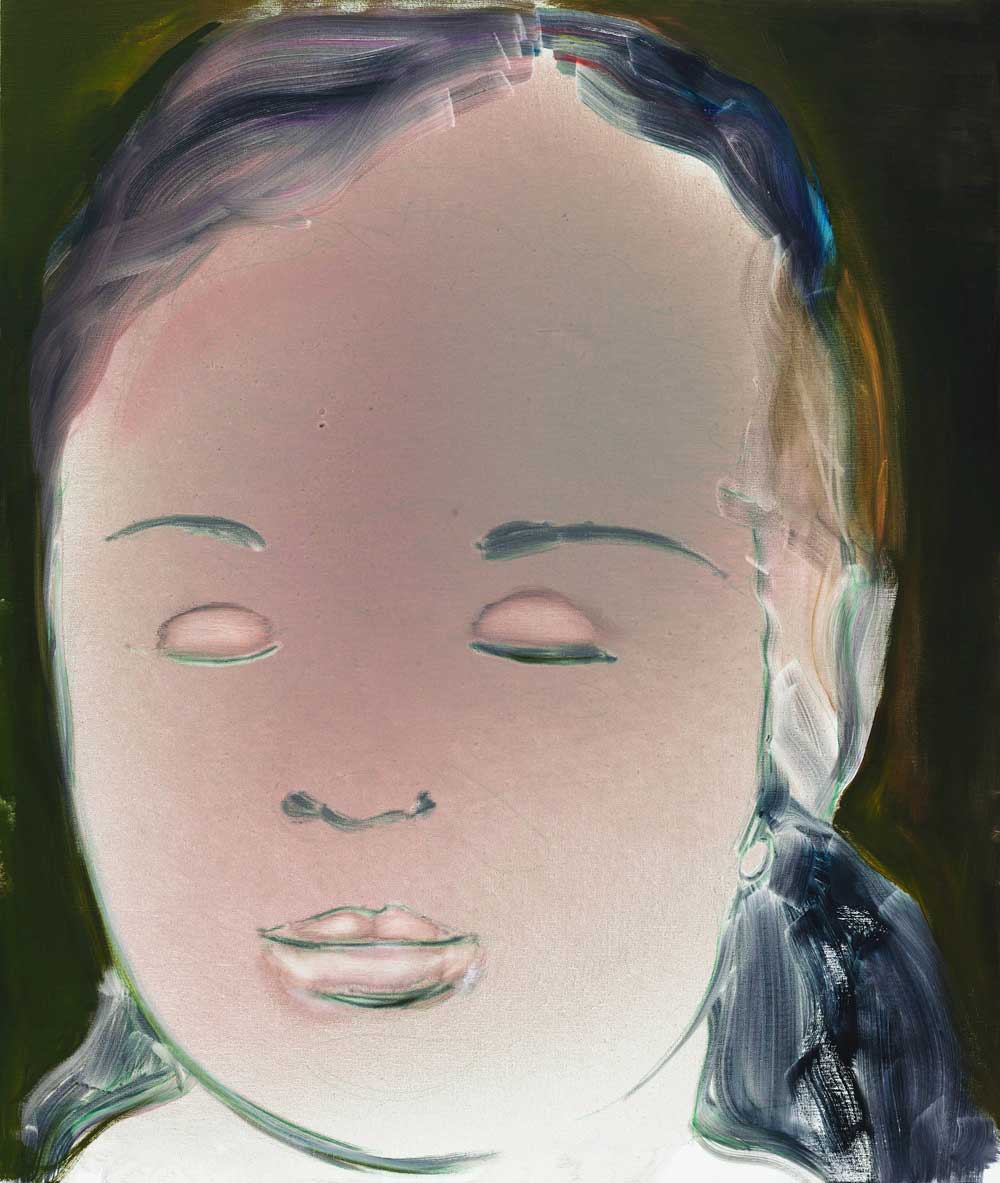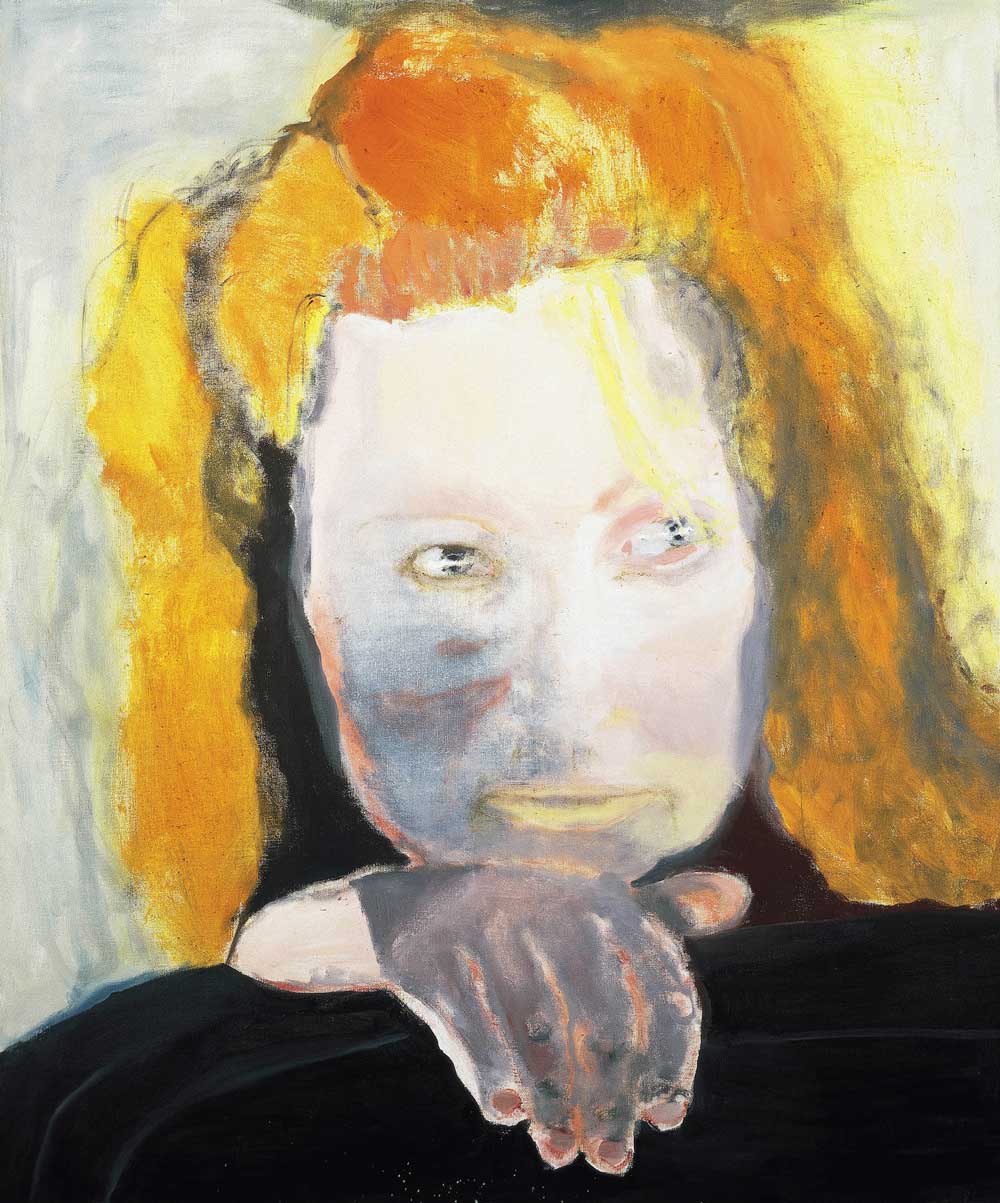Something from nothing: Paintings by Marlene Dumas like 'Helena’s Dream' and 'Amy' form portraits out of minimal paint on the canvas.
A wall of faces greets you in the opening room. Dozens of ink and graphite images look back at us, wonky and misproportioned, but also weirdly right. They’re called Rejects – do their sometimes wild imperfections signal failure, or something else? This is a good way to begin. Should we reject them, too? The series is ongoing, and Marlene Dumas keeps them close – a family full of flaws. It’s their faults that make them human.
There are faces everywhere in these rooms of sex and death. Even when she is painting the dead, Dumas’s work is full of life.
Near the end of Tate Modern’s Dumas retrospective are her large, oil-painted heads of Saint Lucy, left-wing German militant Ulrike Meinhof and an anonymous young woman shot by Russia’s Alpha antiterrorism forces in the 2002 Dubrovka theatre siege in Moscow. The heads remind me of sexual rapture as much as death. I wrote about these paintings 10 years ago, and they’re even more alive to me now.
Born in South Africa, Dumas deals in the paradoxes and ambiguities of both painting and life. Who knows, when they begin a painting, how things will end up? If you want to make God laugh, tell him your plans.
Among these heads is a picture of the skull of Charlotte Corday, who murdered the French revolutionary Jean-Paul Marat in his bath. It’s like a cratered moon. Corday went to the guillotine “without rage”, Dumas observes.

‘Helena’s Dream’ forms part of the comprehensive Marlene Dumas retrospective at the Tate Modern
As well as the dead, there are the crazy, the guilty, the lascivious, the doomed, the misguided, the famous and – in the case of Osama bin Laden – the notorious. Bin Laden looks like an ordinary man in Dumas’s portrait, which, like most of her work, is painted from second-hand images. Even though they are made from thinned-down paint – their colour and pallor from the palette or the dirty turps she washed her brushes in – they have a presence that is entirely different from a photograph.
A series of drawings, made last year for the Manifesta biennial in St Petersburg in the wake of Russia’s anti-lesbian, gay, bisexual, transgender and intersex laws, is a roll call of great men, all of them homosexual and many, like Alan Turing, who suffered or died because of it. They are a kind of commemoration.
Dumas told me she cannot paint anyone without sympathy. She prefers to work from photographs so that she is distanced from her subjects, and can paint with an “amoral” brush. When she painted her daughter, Helena, naked and covered in smears of paint, her hands dripping red and blue, she gave the child’s face a brooding, accusatory expression, a knowing look.
An ageing South African woman with pale blue eyes, in a painting called The White Disease, is based on a medical photograph. What is her disease? Is it the infection of apartheid and a belief in white superiority? You never know what anyone is thinking. And these are paintings, after all.
“Art doesn’t speak unless it’s spoken to,” Dumas says, in one of the wise little texts she has written about her work. What is Lady Di, derived from Lord Snowdon’s Gainsborough-esque photographic portrait, thinking as she gives one of her patented sideways looks at Naomi Campbell, full-frontal on an adjacent canvas? This, and a nearby portrait of Amy Winehouse, strikes a false note – the low point of a show that takes us from rural Afrikaans-speaking South Africa (there is an interesting vitrine of Dumas’s juvenilia) to sex clubs in Amsterdam, and looks at the miseries of war and death.
On the way, we meet Ingrid Bergman bloated and crying in For Whom the Bells Tolls, Sigmund Freud’s wife, filmmaker Pier Paolo Pasolini and his mother, record producer Phil Spector mad in his wig and then sick and bald in jail, and Dumas herself looking over her shoulder in a painting whose title, Evil is Banal, nods to Hannah Arendt and her book about Nazi war criminal Adolf Eichmann.

Marlene Duma’s ‘Evil is Banal’
Looking at Dumas’s paintings, I am often struck by how little there seems to be on the canvas. The images coalesce out of almost nothing. She somehow cajoles her medium into forming a face, a body, an expression – a sense of being. Wiping paint off as often as painting positive, emphatic marks, she gives us cheekbones or a forehead, a proffered anus and balls or a vulva using hardly anything. Going from extreme vagueness to almost crude and snaggly brushstrokes to make an ear or to describe hair, Dumas runs the gamut of painterly effects. The frankness with which she paints draws us in.
It can at first all seem haphazard and a bit chaotic, but that’s life, and that’s the marvellous thing when Dumas’s work comes together. One of the pleasures of this exhibition is seeing how she constantly rediscovers herself and develops her artistic language over the decades. You get a real sense of the artist thinking through action, through all the mistakes and the backtracking.
Dumas’s work is affecting not just because of her subjects or her mastery (with all its masculine associations), but because of its apparent drive and vulnerability, its repeated journeys of discovery and surprise, its plain-spokenness. In any case, risk is better than mastery.
I first encountered her work almost 30 years ago, and I have got to know Dumas well (oddly enough, we were born on the same day in 1953). Yet still she surprises me, even when I come across a work I have known for a long time. Each time I look, it seems new again. This is to do with more than freshness of touch, although the fact that her work is as much a kind of wet drawing, even if it is painted, has something to do with this.
Drawings can seem timeless and immediate in a way paintings often don’t. Drawing wet ink into wet watercolour allows few revisions. Over-painting doesn’t work. The real mystery is that there is no mystery. Dumas can be magnificently awkward, and is at her darkest when her touch is at its lightest, her candour most apparent. – © Guardian News & Media 2015